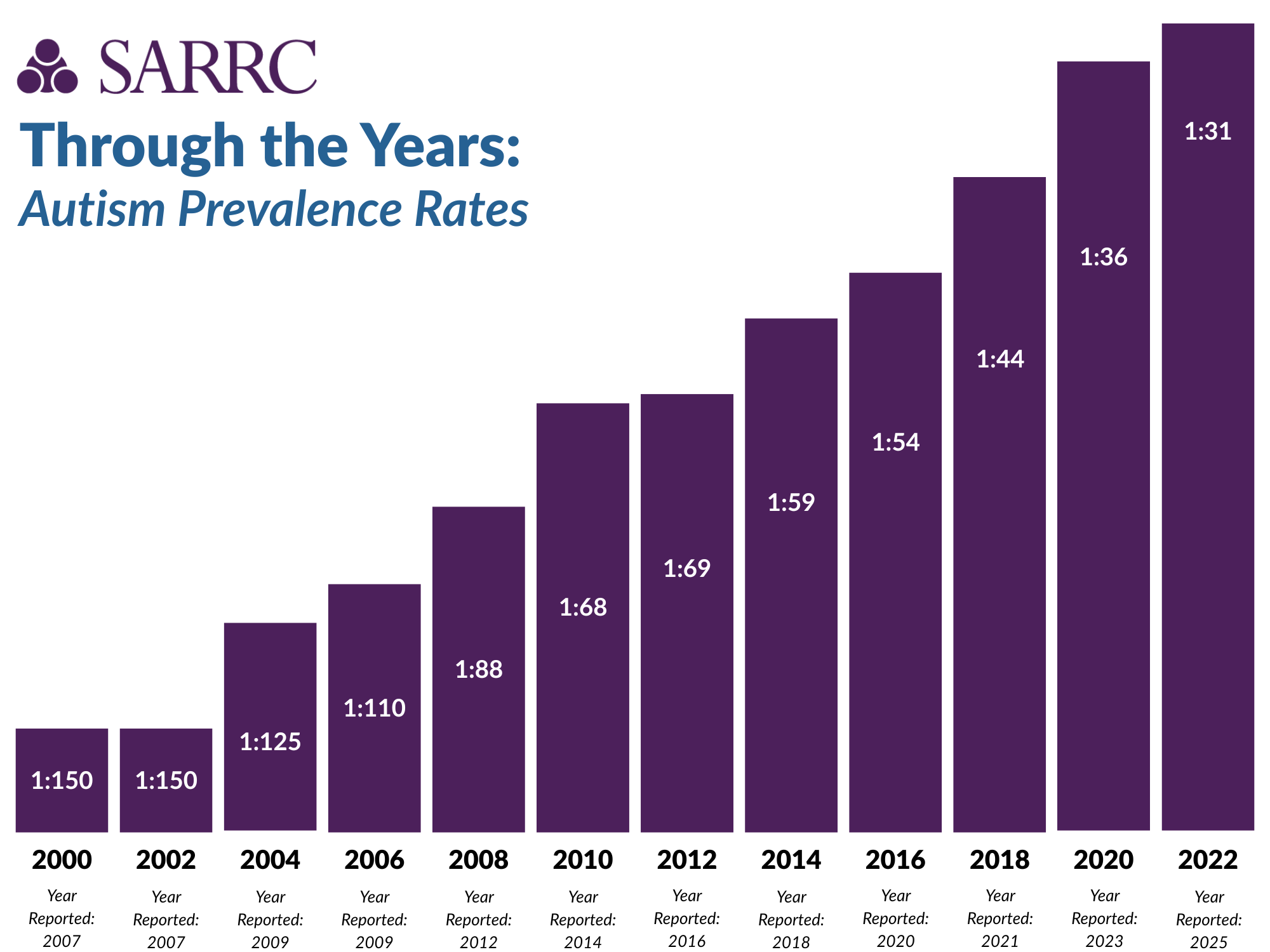On Tuesday, April 15, 2025, the Centers for Disease Control and Prevention (CDC) released new data from the Autism and Developmental Disabilities Monitoring Network (ADDM) reporting that about 1 in 31 8-year-old children in the U.S. were identified with autism spectrum disorder (ASD) in 2022. This new rate is up from the reported 2020 prevalence of 1 in 36.
According to the CDC, a total of 16 sites (located in Arizona, Arkansas, California, Georgia, Indiana, Maryland, Minnesota, Missouri, New Jersey, Pennsylvania, Puerto Rico, Tennessee, Texas [two sites: Austin and Laredo], Utah, and Wisconsin) conducted surveillance for ASD among children aged 4 and 8 years and suspected ASD among children aged 4 years. Surveillance included children who lived in the surveillance area at any time during 2022.
Key Findings
- Asian or Pacific Islander, Black, Hispanic and multiracial children continued to have a higher prevalence of ASD than White children.
- ASD was 3.4 times as prevalent among boys than girls.
- Overall, ASD prevalence was lower among non-Hispanic White children than among Asian or Pacific Islander, American Indian or Alaska Native, non-Hispanic Black or African American, Hispanic or Latino, and multiracial children.
- No association was observed between ASD prevalence and neighborhood median household income (MHI) at 11 sites; higher ASD prevalence was associated with lower neighborhood MHI at five sites.
Read more about key findings from the ADDM Network »
“The updated report and findings show that more children now have access to autism evaluations, leading to an increase in autism diagnoses,” says Christopher J. Smith, Ph.D., SARRC’s chief science officer. “In addition, the last several CDC reports have shown similar prevalence rates, suggesting that the sharp increases may be leveling off.”
He states that this consistency reflects a more accurate and stable understanding of autism prevalence.
“Still, the ADDM reports continue to provide valuable insights into trends within the autism community, particularly the encouraging shift toward earlier diagnosis. With each report, a growing percentage of children are evaluated at younger ages, signaling progress in the right direction,” shares Smith.
If parents have concerns, they should discuss their child’s development with their pediatrician and request a referral specifically for a developmental evaluation, or they can pursue a developmental evaluation on their own by contacting autism organizations like SARRC. Learn more about early indicators of autism »
Key Findings in Arizona
In 2022, the Arizona Developmental Disabilities Surveillance Program (ADDSP), one of 16 sites in the ADDM Network, identified about 1 in 32 8-year-old children with autism in Arizona. Findings from ADDSP help improve understanding of how many children have autism, their characteristics, and the age at which they are first evaluated and diagnosed.
Among 8-year-old children with autism, 55.4% had received a comprehensive developmental evaluation by age 3. Additionally, boys were 3.5 times more likely than girls to be identified with autism.
“The autism prevalence in Arizona, and within all sites, tells an interesting story. Trends revealed through the updated report continue to raise awareness and urgency, while also casting a watchful eye on the significant changes in our healthcare systems, such as revisions in diagnostic criteria and efforts to improve early detection and screening,” shares Dr. Smith.
Understanding the Root Causes of Autism
Beyond prevalence, Dr. Smith shares it’s important to understand the underlying complexity of autism. “The causes of autism are as diverse as the autism community itself, and there isn’t a single explanation,” he shares.
“Autism begins with a disruption in the learning process, where children don’t absorb information from their environment as effectively as typically developing children. This difference in how they learn contributes to developmental delays. Many factors can interfere with this process. Strong evidence points to a genetic influence on brain development, with some findings suggesting these differences may begin as early as in the womb.”
He states there is also evidence to show that subtle differences in eye gaze are identifiable in the first year of life, that emerge long before the first observable signs of autism.
Finally, Dr. Smith emphasizes there is more than a decade of research, and a number of very well-designed and large-scale studies have shown that there is no evidence for a causal link between vaccines and autism.
See this link for more information on the evidence around the causes of autism »
Learn more about early intervention services at SARRC
Diagnostic Services »
Do you suspect autism or have concerns about your child’s development?
Easy Access Autism Screening »
If you have concerns about your child’s development and want answers fast, access a free developmental screening with our team.
Milestones »
A free program offering information on developmental milestones for parents of infants ages 6 to 18 months.
Free Online Family Orientation »
Monthly meetings that connect parents to current information and resources related to ASD.

